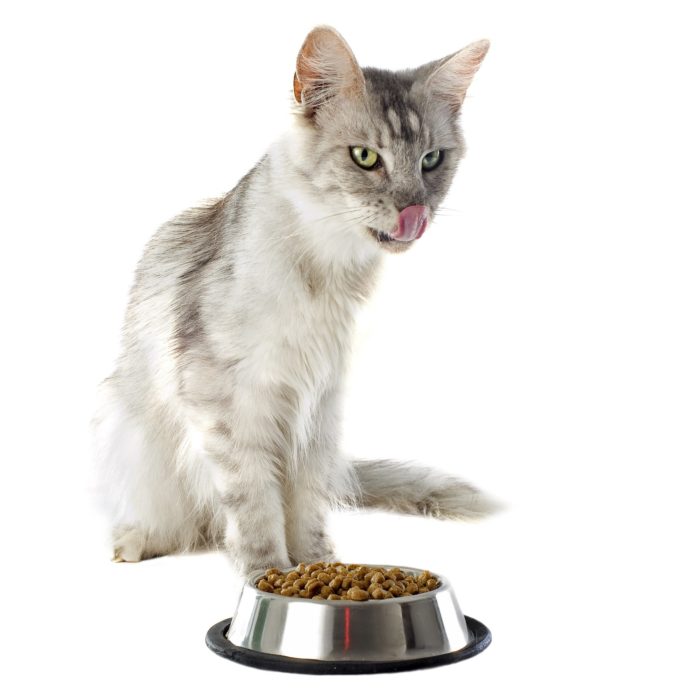Your cat has a ravenous appetite but never gains weight and might even be losing weight. In addition, you may notice the litter box has more deposits than ever before—often soft and “slimy” with a worse odor than usual. Your cat may be suffering from a malabsorption/maldigestion disorder. Malabsorption means the cat can’t absorb the nutrients. Maldigestion occurs when your cat is not producing the enzymes needed to digest her food.
Digestion Gone Awry
The pancreas produces most of the digestive enzymes. Pancreatitis, which is inflammation of the pancreas, can cause leakage of digestive enzymes inside the pancreas. Without enough digestive enzymes, your cat can’t properly digest her food.
A lack of digestive enzymes may be corrected with pancreatic enzyme supplements. The supplements contain proteases to digest proteins, lipases to help with fat digestion, and amylase to assist with carbohydrate digestion.
Intestinal Difficulties
The intestines are lined with epithelial cells that have small projections called microvilli that increase the surface area of the intestines and aid in digestion and absorption of nutrients. Anything that interferes with the actions or health of the microvilli can cause malabsorption.
Among these interfering culprits are pathogenic bacteria. Feline intestines have plenty of bacteria that normally live there, and many, if not most, are helpful. They may aid in digestion or simply take up space and block pathogenic bacteria.
E. coli (Escherichia coli) is one type of bacteria that has both pathogenic and beneficial versions that can be present in the intestines. Also, think of Salmonella and Campylobacter that, along with various Clostridia, can be pathogenic in humans, cats, and other species.
Pathogenic bacteria can interfere with the absorption of nutrients in a couple of different ways. Physically, they can attach to microvilli and prevent nutrient movement. They can also produce toxins that cause diarrhea and inhibit absorption of nutrients.
Dr. Jodi Gookin at North Carolina State notes that another bacterial pair shows both “good” and “bad,” just like E coli. “Enterococcus hirae is the most popular enterococcus for a healthy kitten to have inside the small intestine,” she says. In contrast, Enterococcus faecalis is associated with illness.
Along with bacteria, protozoal parasites can interfere with the cat’s normal digestion and absorption of nutrients.
Under Control
Malabsorption can have a wide range of causes, but with a step-by-step plan, we can arrive at a diagnosis and come up with a treatment plan to help your cat. Understand that treatment may be necessary for the life of your cat.
Inflammatory Bowel Disease Is Often the Cause
Vomiting is a primary symptom; it most often begins in middle age
Inflammatory bowel disease (IBD) may be the biggest cause of malabsorption in cats. The most common inflammatory cells are lymphocytes, plasmacytes, and eosinophils. These cells act as part of your cat’s immune system and usually provide life-saving functions from invading organisms. When they go awry, they can cause serious health problems.
IBD tends to occur in middle-aged cats. The stomach can be involved, with vomiting as a primary sign. Alternatively, it can be primarily an intestinal problem with malabsorption and diarrhea. A definitive diagnosis requires a biopsy of tissue from the stomach wall and/or intestinal lining. This may be done via endoscopy or might require an abdominal surgery.
Treatment often requires trial and error. Diet change is usually part of the treatment. A true diet test means your cat must ONLY eat the test diet for six to 12 weeks. If you have a multi-cat household that may mean all cats go on the diet, especially if you free feed. Diet may or may not control the symptoms.
Immunosuppressive medications, such as prednisone, may be needed to control your cat’s IBD. These medications tend to be started at a relatively high dose, with gradual reduction to the minimum dose required to keep the IBD under control. This is not an illness that is generally cured, but rather is controlled.
During the initial attempts to get the IBD under control, your veterinarian may also prescribe antibiotics or other enteric medications to decrease populations of pathogenic bacteria. Fecal examinations will need to be done to rule out any parasites, including protozoa. Any such intestinal pathogens will need to be treated first. Probiotics may be offered as assistance in getting the intestinal bacterial flora back to normal.




